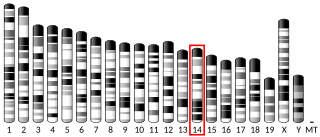
Runt-related transcription factor 3 is a protein that in humans is encoded by the RUNX3 gene.

Death-associated protein kinase 1 is an enzyme that in humans is encoded by the DAPK1 gene.

Retinoic acid receptor beta (RAR-beta), also known as NR1B2 is a nuclear receptor that in humans is encoded by the RARB gene.

Growth arrest and DNA-damage-inducible, beta, also known as GADD45B, is a protein which in humans is encoded by the GADD45B gene.

Deleted in Liver Cancer 1 also known as DLC1 and StAR-related lipid transfer protein 12 (STARD12) is a protein which in humans is encoded by the DLC1 gene.

Hepatoma-derived growth factor (HDGF) also known as high mobility group protein 1-like 2 (HMG-1L2) is a protein that in humans is encoded by the HDGF gene.

Retrotransposon-derived protein PEG10 is a protein that in humans is encoded by the PEG10 gene.

Fibroblast growth factor 19 is a protein that in humans is encoded by the FGF19 gene. It functions as a hormone, regulating bile acid synthesis, with effects on glucose and lipid metabolism. Reduced synthesis, and blood levels, may be a factor in chronic bile acid diarrhea and in certain metabolic disorders.

PIN2/TERF1-interacting telomerase inhibitor 1, also known as PINX1, is a human gene. PINX1 is also known as PIN2 interacting protein 1. PINX1 is a telomerase inhibitor and a possible tumor suppressor.

Epithelial membrane protein 3 (EMP3) is a trans-membrane signaling molecule that is encoded by the myelin-related gene EMP3. EMP3 is a member of the peripheral myelin protein gene family 22-kDa (PMP22), which is mainly responsible for the formation of the sheath of compact myelin. Although the detailed functions and mechanisms of EMP3 still remain unclear, it is suggested that EMP3 is possibly epigenetically linked to certain carcinomas.

Zinc transporter SLC39A7 (ZIP7), also known as solute carrier family 39 member 7, is a transmembrane protein that in humans is encoded by the SLC39A7 gene. It belongs to the ZIP family, which consists of 14 proteins that transport zinc into the cytoplasm. Its primary role is to control the transport of zinc from the ER and Golgi apparatus to the cytoplasm. It also plays a role in glucose metabolism. Its structure consists of helices that bind to zinc in a binuclear metal center. Its fruit fly orthologue is Catsup.

Metadherin, also known as protein LYRIC or astrocyte elevated gene-1 protein (AEG-1) is a protein that in humans is encoded by the MTDH gene.

Bcl-2/adenovirus E1B 19 kDa-interacting protein 2-like protein is a protein that in humans is encoded by the BNIPL gene.

Copine-1 is a protein that in humans is encoded by the CPNE1 gene.

The jumping translocation breakpoint protein (JTB), also known as prostate androgen-regulated protein (PAR), is a protein that in humans is encoded by the JTB gene. It is an orphan receptor with unknown function.

PCNA-associated factor is a protein that in humans is encoded by the KIAA0101 gene.

Gene HEPACAM*, named based on its original site of identification - hepatocytes and the nature of its protein product - a cell adhesion molecule (CAM), was first discovered and characterised in human liver and reported by Shali Shen in 2005. The gene encodes a protein of 416 amino acids, designated as hepaCAM**, which is a new member of the immunoglobulin superfamily of cell adhesion molecules. The main biological functions of hepaCAM include a) modulating cell-matrix adhesion and migration, and b) inhibiting cancer cell growth.

ADP/ATP translocase 2 is a protein that in humans is encoded by the SLC25A5 gene on the X chromosome.

TSPY like 5 is a protein that in humans is encoded by the TSPYL5 gene.
















